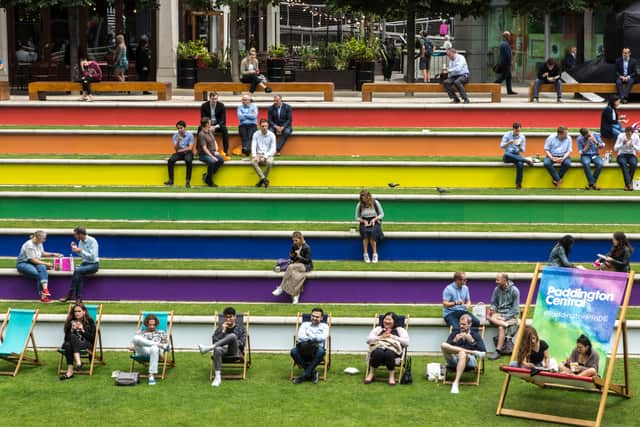Stonewall LGBTQ+ report: findings explained, what do letters stand for - how many Gen Zers identify as LGBTQ
and live on Freeview channel 276
A report in to people’s sexual and gender identifies has been published by the UK’s lesbian, gay, bisexual and transgender rights charity, Stonewall.
The report reveals that Britain is now a “rainbow” nation, according to the charity, and that the LGBTQ+ community is now thriving.
Advertisement
Hide AdAdvertisement
Hide AdSo, just what exactly does LGBTQ+ mean and what exactly does Stonewall’s report say?
Here’s everything you need to know.


What does LGBTQ+ stand for?
LGBTQ+ is the acronym for lesbian, gay, bisexual, transgender, queer, questioning and ace, according to Stonewall, the UK’s lesbian, gay, bisexual and transgender rights charity.
For a full list of LGBTQ+ terms and what they stand for, you can visit the official Stonewall website.
What is the Stonewall LGBTQ+ report?
The report from Stonewall is called ’Attraction, identity and connection in Great Britain in 2022’.
Advertisement
Hide AdAdvertisement
Hide AdIt has been put together using data from Ipsos UK, a market research company in the UK and Ireland, and it paints a picture of Britain and the variety of ways that people of different generations identify themselves.
What does the Stonewall LGBTQ+ report say?
There are stark differences between the generations, according to the report, with more younger people identifying as lesbian, gay, bi and trans.
In Gen Z, only 71% of people identify as straight, compared to 91% of baby boomers, and 14% of people identify as bisexual or pansexual, compared to just 2% of baby boomers.
For the purpose of the report, people who are a part of the baby boomer generation are aged 56 and 75 and people who are a part of the Generation Z are aged between 16 and 26.
Advertisement
Hide AdAdvertisement
Hide AdThe data also revealed that just 53% of Gen Z are exclusively straight, and 40% have a pattern of attraction that could be described as queer, which is something outside the scope of exclusively heterosexual attractions between cisgender people.
The report also found that only just over half of Gen Z (53%) are exclusively attracted to people of the opposite sex, compared to over three quarters (77%) of the baby boomers.
Taking account of the 7% who don’t know, or prefer not to say, two in five (40%) of the youngest people in our survey have attractions that are queer.
The percentage of people who say they are only attracted to people of the same sex is relatively stable across generations. Among generation Z, just 7% of people say they feel this way, compared to 8% of the oldest cohort, however, the percentage of people whose attractions align with bisexual or pansexual orientations looks very different by age; 28% of Gen Z are attracted to both sexes, compared to just 11% of baby boomers.
Why are there differences in how people identify between the generations?
Advertisement
Hide AdAdvertisement
Hide AdThe difference in how people identify themselves may be because of the change in attitudes, according to Stonewall.
A spokesperson for the charity said: “As societies become less hostile to LGBTQ+ people, and as LGBTQ+ people are more visible in public life, more and more of us feel comfortable coming out, and living our full lives.”
Who was spoken to for the data for the report?
The data used in the report was taken from three surveys using Ipsos’ online Omnibus.
Ipsos interviewed a representative quota sample of 2,150 Britons aged 16 to 75 from 10 to 14 June. A second poll was then conducted with a representative quota sample of 2,176 Britons aged 16 to 75 from 10 to 13 June. A third and final poll was conducted with a representative quota sample of 2,187 Britons aged 16 to 75 from 5 to 8 August 2022.
What have Stonewall said about the findings of the report?
Advertisement
Hide AdAdvertisement
Hide AdA spokeperson for Stonewall said: “Our polling with Ipsos paints a clear picture of a rainbow Britain: a country where, generation by generation, more of us feel able to use lesbian, gay and bi labels to describe our sexual orientations.
“This suggests that in a single lifetime we may have travelled from a world in which lesbian, gay, bi and queer relationships were hidden and LGBTQ+ people were criminalised, to one in which we are a thriving and growing community and we are seen, known and loved by the community around us.
“Some 39% of the public have a personal friend or family member who is lesbian or gay, 22% have a personal friend or family member who is bisexual, and 9% have a personal friend or family member who is trans. As more lesbian, gay, bi and trans people feel safe to come out, we expect these numbers will only rise.”
Comment Guidelines
National World encourages reader discussion on our stories. User feedback, insights and back-and-forth exchanges add a rich layer of context to reporting. Please review our Community Guidelines before commenting.
